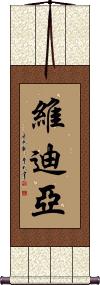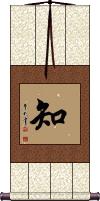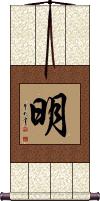Many custom options...
And formats...

Vidya in Chinese / Japanese...
Buy a Vidya calligraphy wall scroll here!
Personalize your custom “Vidya” project by clicking the button next to your favorite “Vidya” title below...
Vidya
Vidya
Realization and Knowledge
知 means realization or true knowing.
This can also translate as to know, to be aware, wisdom, or higher knowledge.
From older Buddhist ideas, this can represent विद्या (Vidyā or Vidya) or ज्ञान (Jñāna or Jnana) and even the combination Sanskrit word विज्ञान (Vijñāna or Vijnana) which can translate as wisdom arising from perception or knowing.
However, 知 should be distinguished as true knowing versus having a relative understanding or 會.
Light / Bright
明 means light, bright, clear, clarity, to understand, or wise.
In Chinese, this can refer to the Ming Dynasty (1368-1644) where it can also be the surname Ming.
In Japanese, this can be romanized many different ways when used as surnames or given names. 明 is a partial list of those names: Meishuu, Mei, Min, Myoujin, Myou, Hinata, Haru, Toshi, Tooru, Sayaka, Saya, Satoshi, Asumi, Akera, Akemine, Akesaki, Ake, Akuru, Akiraka, and Akira.
In the Buddhist context, this represents vidyā (knowledge). To expand that, Buddhists understand this to mean bright, clear, enlightenment, wisdom, or to understand. It represents Buddha-wisdom and its revelation; also the manifestation of a Buddha's light or effulgence.
Not the results for Vidya that you were looking for?
Below are some entries from our dictionary that may match your Vidya search...
| Characters If shown, 2nd row is Simp. Chinese |
Pronunciation Romanization |
Simple Dictionary Definition |
明 see styles |
míng ming2 ming meishuu / meshu めいしゅう |
More info & calligraphy: Light / Bright(1) (ant: 暗) brightness; (2) discernment; insight; an eye (for); (3) (See 明を失う) eyesight; vision; (prefix) (4) (abbreviation) (See 明治) nth year in the Meiji era (1868.9.8-1912.7.30); (surname) Meishuu vidyā, knowledge. ming means bright, clear, enlightenment, intp. by 智慧 or 聰明 wisdom, wise; to understand. It represents Buddha-wisdom and its revelation; also the manifestation of a Buddha's light or effulgence; it is a term for 眞言 because the 'true word' can destroy the obscurity of illusion; the 'manifestation' of the power of the object of worship; it means also dhāraṇīs or mantras of mystic wisdom. Also, the Ming dynasty A. D. 1368-1644. |
知 see styles |
zhī zhi1 chih tomoko ともこ |
More info & calligraphy: Realization and Knowledge(1) wisdom; (2) (Buddhist term) jnana (higher knowledge); (female given name) Tomoko To know. Sanskrit root vid, hence vidyā, knowledge; the Vedas, etc. 知 vijñā is to know, 智 is vijñāna, wisdom arising from perception or knowing. |
費 费 see styles |
fèi fei4 fei hi ひ |
More info & calligraphy: Fe(suffix noun) cost; expense; (surname) Hi To spend, lavish, waste, squander; expense: translit. vi, ve, in vidyā, v. 明; viṇā, a lute, v. 批; Veda, the Vedas, v. 韋. |
五明 see styles |
wǔ míng wu3 ming2 wu ming gomei / gome ごめい |
(hist) the five sciences of ancient India (grammar and composition, arts and mathematics, medicine, logic, and philosophy); (surname) Gomei pañca-vidyā, the five sciences or studies of India: (1) śabda, grammar and composition; śilpakarmasthāna, the arts and mathematics; cikitsā, medicine; hetu, logic; adhyātma, philosophy, which Monier Williams says is the 'knoowledge of the supreme spirit, or of ātman', the basis of the four Vedas; the Buddhists reckon the Tripiṭṭaka and the 十二部教 as their 内明, i. e. their inner or special philosophy. |
内明 see styles |
mitsuaki みつあき |
{Buddh} (See 五明) adhyatma vidya (one of the five sciences of ancient India); science of spirituality; (personal name) Mitsuaki |
因明 see styles |
yīn míng yin1 ming2 yin ming inmyou / inmyo いんみょう |
(See 五明) hetuvidya (ancient Indian logic for determining right from wrong, truth from falsehood, etc.) Hetuvidya, 醯都費陀, the science of cause, logical reasoning, logic, with its syllogistic method of the proposition, the reason, the example. The creation of this school of logic is attributed to Akṣapāda, probably a name for the philosopher Gautama (not Śākyamuni). The 因明論 or Hetu-vidyā-śāstra is one of the 五明論 pañcavidya-śāstras, a treatise explaining causality, or the nature of truth and error. |
毘睇 毗睇 see styles |
pí dì pi2 di4 p`i ti pi ti bitei |
vidyā, 毘底牙 knowledge, learning, philosophy, science; incantation; intp. 明呪 an incantation to get rid of all delusion. The Vidyādharapiṭaka is a section of incantations, etc., added to the Tripiṭaka. |
功巧論 功巧论 see styles |
gōng qiǎo lùn gong1 qiao3 lun4 kung ch`iao lun kung chiao lun Kukō ron |
功明論 (or 巧明論) Śilpasthāna-vidyā-śāstra; 'the śāstra of arts and sciences, ' i. e. of 術 and 數, one of the 五明 five works on knowledge; it treats of 'arts, mechanics, dual philosophy, and calendaric calculations'. Eitel. |
尾底牙 see styles |
wěi dǐ yá wei3 di3 ya2 wei ti ya biteiga |
vidyā |
工巧明 see styles |
gōng qiǎo míng gong1 qiao3 ming2 kung ch`iao ming kung chiao ming kugyoumyou / kugyomyo くぎょうみょう |
(hist) (See 五明) silpasthanavidya (ancient Indian study of the arts, incl. mathematics and mechanics) Śilpasthana-vidyā. 巧業明 One of the five departments of knowledge dealing with the arts, e. g. the various crafts, mechanics, natural science (yin-yang), calculations (especially for the calendar and astrology), etc. |
明行足 see styles |
míng xíng zú ming2 xing2 zu2 ming hsing tsu myōgyō soku |
vidyā-caraṇa-saṃpañña; knowledge-conduct-perfect 婢侈遮羅那三般那. (1) The unexcelled universal enlightenment of the Buddha based upon the discipline, meditation, and wisdom regarded as feet; one of the ten epithets of Buddha. Nirvāṇa Sūtra 18. (2) The 智度論 2 interprets 明 by the 三明 q. v., the 行 by the 三業 q. v., and the 足 by complete, or perfect. |
成唯識論 成唯识论 see styles |
chéng wéi shì lùn cheng2 wei2 shi4 lun4 ch`eng wei shih lun cheng wei shih lun Jō yuishiki ron |
Vidya-matrāṣiddhi śāstra, in 10 juan, being Vasubandhu's 唯識 in 30 juan reduced by Xuanzang, also by others, to 10. There are works on it by various authors. |
攝拖苾馱 摄拖苾驮 see styles |
shè tuō bì tuó she4 tuo1 bi4 tuo2 she t`o pi t`o she to pi to shōtahita |
Śabda-vidyā, (a śāstra on) grammar, logic. |
步擲明王 步掷明王 see styles |
bù zhí míng wáng bu4 zhi2 ming2 wang2 pu chih ming wang Buchaku myōō |
Padana-kṣipa-vidyā-rāja |
步擲金剛 步掷金刚 see styles |
bù zhí jīn gāng bu4 zhi2 jin1 gang1 pu chih chin kang Buchaku kongō |
or 步擲明王; 播般曩結使波 A form of 普賢 Samantabhadra as a vajra-king. |
醯都費陀 醯都费陀 see styles |
xì dū fèi tuó xi4 du1 fei4 tuo2 hsi tu fei t`o hsi tu fei to keito hida |
hetuvidyā, 因明, logic. |
大威徳明王 see styles |
daiitokumyouou / daitokumyoo だいいとくみょうおう |
{Buddh} Yamantaka Vidya-raja; conqueror of Death |
毘侈遮羅那 毘侈遮罗那 see styles |
pí chǐ zhē luó nà pi2 chi3 zhe1 luo2 na4 p`i ch`ih che lo na pi chih che lo na bishisharana |
(Skt. vidyā-caraṇa-saṃpanna) |
降三世明王 see styles |
xiáng sān shì míng wáng xiang2 san1 shi4 ming2 wang2 hsiang san shih ming wang gouzanzemyouou / gozanzemyoo ごうざんぜみょうおう |
{Buddh} Trailokyavijaya Vidya-raja; conqueror of the three worlds conqueror of the three worlds |
鞞侈遮羅那 鞞侈遮罗那 see styles |
bǐ chǐ zhē luó nà bi3 chi3 zhe1 luo2 na4 pi ch`ih che lo na pi chih che lo na |
(鞞侈遮羅那三般那) or 毘侈遮羅那 (毘侈遮羅那三般那) or鞞多遮羅那 (鞞多遮羅那三般那) or毘多遮羅那 (毘多遮羅那三般那) vidyā-caraṇa-saṃpanna, perfect in knowledge and conduct 明行足, one of the ten epithets of a Buddha. |
播般曩結使波 播般曩结使波 see styles |
bò bān nǎng jié shǐ bō bo4 ban1 nang3 jie2 shi3 bo1 po pan nang chieh shih po Hahannōketsushiha |
bānnǎngjiéshǐbō] ; Padana-kṣipa-vidyā-rāja |
毘侈遮羅那三般那 毘侈遮罗那三般那 see styles |
pí chǐ zhē luó nà sān bān nà pi2 chi3 zhe1 luo2 na4 san1 ban1 na4 p`i ch`ih che lo na san pan na pi chih che lo na san pan na bishisharana sanpanna |
(Skt. vidyā-caraṇa-saṃpanna) |
鞞侈遮羅那三般那 see styles |
bǐ chǐ zhē luó nà sān bān nà bi3 chi3 zhe1 luo2 na4 san1 ban1 na4 pi ch`ih che lo na san pan na pi chih che lo na san pan na |
(Skt. vidyā-caraṇa-saṃpanna) |
馬頭觀音心陀羅尼 see styles |
mǎ tóu guān yīn xīn tuó luó ní ma3 tou2 guan1 yin1 xin1 tuo2 luo2 ni2 ma t`ou kuan yin hsin t`o lo ni ma tou kuan yin hsin to lo ni |
Hayagrīva-vidyā |
大佛頂如來放光悉憺多鉢憺陀羅尼 大佛顶如来放光悉憺多钵憺陀罗尼 see styles |
dà fó dǐng rú lái fàng guāng xī dá duō bō dá luó tuó luó ní da4 fo2 ding3 ru2 lai2 fang4 guang1 xi1 da2 duo1 bo1 da2 luo2 tuo2 luo2 ni2 ta fo ting ju lai fang kuang hsi ta to po ta lo t`o lo ni ta fo ting ju lai fang kuang hsi ta to po ta lo to lo ni Dai bucchō nyorai hōkō Shittatahattara darani |
Dhāraṇī of Śitātapatra, Great Corona of All Tathāgatas, Radiating Light [The Great Queen of Vidyā called Aparājitā] |
The following table may be helpful for those studying Chinese or Japanese...
| Title | Characters | Romaji (Romanized Japanese) | Various forms of Romanized Chinese | |
| Vidya | 維迪亞 维迪亚 | wéi dí yà wei2 di2 ya4 wei di ya weidiya | wei ti ya weitiya |
|
| Vidya | ビディア | bidia | ||
| Realization and Knowledge | 知 | chi | zhī / zhi1 / zhi | chih |
| Light Bright | 明 | mei / myou / mei / myo | míng / ming2 / ming | |
| In some entries above you will see that characters have different versions above and below a line. In these cases, the characters above the line are Traditional Chinese, while the ones below are Simplified Chinese. | ||||
Successful Chinese Character and Japanese Kanji calligraphy searches within the last few hours...







